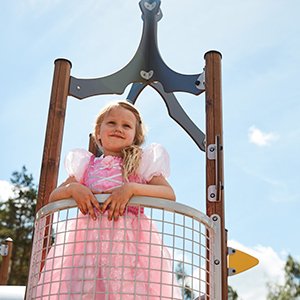Social Experience
A playground should give children the opportunity to engage in social play and cooperate with other children. In this section we will look at interaction, dramatic and imaginative play.
Interaction
Give children the opportunity to play with each other by choosing equipment that requires two or more people to participate, such as seesaws or other play equipment designed for more than one person. This will encourage the social side of play - playing with others and making new friends.
Other equipment for socialising could include sand, water and nature play, and group seating areas where there is space for several people to sit together. Create spaces where children can watch and copy each other, where they can learn from each other and enjoy each other's company.

Roleplay
Roleplay gives children the opportunity to use their linguistic, cognitive and social skills. It is helpful if playgrounds can give children the chance to create play "themes" and act them out by participating in different roles that are spontaneous, child-initiated and open-ended. Use a mix of abstract and realistic play equipment and features, such as themed play frames, a shop, a bridge, a train, a boat or a playhouse.
Where possible, loose objects and props that can be used creatively and flexibly without requiring great physical ability or motor skills are a good idea. Loose objects such as buckets, blocks or sticks can be moved and carried around, combined in different ways, taken apart and put back together. They can act as tools for sand, soil and water, mobile games or sports equipment. Children can use this type of material as they wish to change the environment and increase opportunities for social, creative and imaginative play.
Contact us, we will be happy to help you with the planning and design of your playground.




